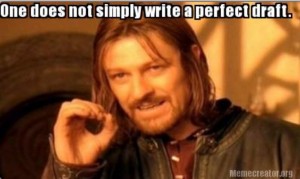 One of the exercises I assign to many of my writing classes goes like this:
One of the exercises I assign to many of my writing classes goes like this:
Imagine a popular film was actually a story or novel submitted to this workshop. Write a critique, using the guidelines I’ve set out for workshopping. This is your chance to say: “Dear Joss, I’ve had a chance to review your story ‘Buffy the Vampire Slayer’ and…”
It’s a fun exercise, and spawns lots of conversations about films and about critiquing.
Now I’m trying to generate a few examples to go with the exercise. I asked my social media followship to help me choose a film that would work well. I got great answers, but ended up deciding there wasn’t a single one-movie-fits-all answer that met all my teaching needs. Now I’m breaking the task into sections.
Critique in a lot of workshops, mine include, starts with the portion of the process where you say what is working with a particular piece. Here’s my handy sample for that:
…for example, if I wanted to write a critique of a novel called Die Hard, by a couple of guys named Steve and Jed, I might say:
GOOD THINGS:
-There’s no doubt that this is John McClane’s story–he’s the guy with both an internal conflict and a goal. The former is his struggle to accept his wife’s independence, and the fact that she has struck out on her own. The external struggle, of course, is the one which occupies most of the story–his fight with the thieves in Nakatomi Plaza.
-The tone you set in this piece is nicely balanced. The action moves along and we’re never bored. The bad guys seem genuinely dangerous, especially Hans Gruber, and yet the humorous moments play well.
-John’s very much a guy of the Eighties and his uneasy and incomplete concessions to feminism reflect that attitude. Held to the standards of the present day, he doesn’t seem that enlightened; it may be that this story doesn’t score perfectly on that front either. But we are looking at something that’s set about thirty years ago. And I think it’s praiseworthy that Holly Gennaro isn’t there merely to motivate John in his fight against Gruber and company. She stands up to Gruber, and works hard to keep a lid on a terrifying situation, thereby protecting the other hostages while hiding her true identity from the thieves.
-Your use of Holly’s last name as a plot device is especially brilliant. It’s a bone of contention between John and Holly. Because they’re fighting about it, it’s already on our radar as Gruber tries to figure out who is causing him such problems and whether he might have any leverage on John. This is a classic example of a story element that works on more than one level.
What you should all notice about this is that I’m not just saying what I like–I’m going into as much detail as I can about why it works.
I’ll be doing this for other elements of critique, including things that don’t work in some other movie.


